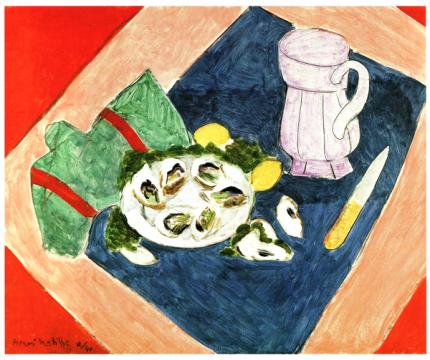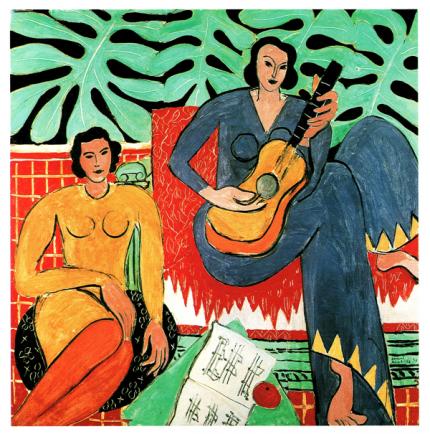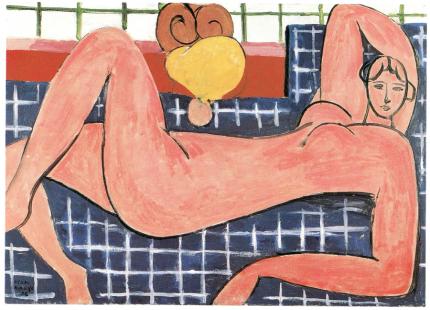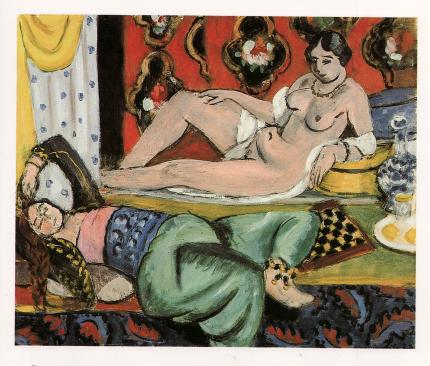-
Par MMaxi le 29 January 2010 à 02:00

Henri Matisse
Stilleven met oesters, 1940
Olieverf op linnen, 65,5 x 81,5 cm
-
Par MMaxi le 21 January 2010 à 20:35

Bij Interieur met etruskische vaas 1940 wordt de decoratieve stijl intiemer weergegeven. De verf is minder glad en de vormen zijn zachter. Het meisje zit te lezen in de zwarte kamer tussen de bladeren van de woekerende planten. Ze wordt op de voorgrond geplaatst door het lichte ram dat de achterwand van de kamer onderbreekt. Aan de de achterwand hangen tekeningen, echter zonder programmatische betekenis voor de vormgeving van het schilderij zoals bij *Dame in blauw het geval was. De lijnen geven met verschillende sterkte meer dimensie weer, ze zijn opener en geven de kleur meer vrijheid zich te ontplooien.Naast zuivere kleuren zijn er ook mengkleuren te zien, waardoor een intieme sfeer wordt bereikt.
Dat er tussen de verschillend elementen van een doek voldoende spanning moet blijven, nam Matisse altijd in ogenschouw.
Lost in Translation Ogenschouw = Look
look |loŏk|
verb [ intrans. ]
1 direct one's gaze toward someone or something or in a specified direction :
people were looking at him | they looked up as he came quietly into the room.
**Fauvism, French Fauvisme, style of painting that flourished in France from 1898 to 1908; it used pure, brilliant color, applied straight from the paint tubes in an aggressive, direct manner to create a sense of an explosion on the canvas. The Fauves painted directly from nature as the Impressionists had before them, but their works were invested with a strong expressive reaction to the subjects they painted. First formally exhibited in Paris in 1905, Fauvist paintings shocked visitors to the annual Salon d'Automne; one of these visitors was the critic Louis Vauxcelles, who, because of the violence of their works, dubbed the painters "Les Fauves" (Wild Beasts).
The leader of the group was Henri Matisse , who had arrived at the Fauve style after careful, critical study of the masters of Postimpressionism Paul Gauguin, Vincent Van Gogh and Georges Seurat Matisse's methodical studies led him to reject traditional renderings of three-dimensional space and to seek instead a new picture space defined by movement of color. Matisse exhibited his famous "Woman with the Hat" (Walter A. Haas Collection, San Francisco) at the 1905 exhibition; brisk strokes of color--blues, greens, and reds--form an energetic, expressive view of the woman. As always in Matisse's Fauve style, his painting is ruled by his intuitive sense of formal order.
Other members of the group included two painters from Chatou, Fr., André Derain and Maurice de Vlaminck, who, together with Matisse, formed the nucleus of the Fauves. Derain's Fauve paintings translate every tone of a landscape into pure color, applied with short, forceful brushstrokes. The agitated swirls of intense color in Vlaminck's works are indebted to the expressive power of van Gogh. Three young painters from Le Havre were also attracted to Fauvism by the strong personality of Matisse. Othon Friesz found the emotional connotations of the bright Fauve colors a relief from the mediocre Impressionism he practiced; his companion Raoul Dufy developed a rather carefree ornamental version of the bold style that suited his own personal aesthetic nature; and Georges Braque created a definite sense of rhythm and structure out of small spots of color, foreshadowing his development of Cubism. Albert Marquet, Matisse's fellow student at the École des Beaux-Arts in the 1890s, also participated in Fauvism, as did the Dutchman Kees van Dongen, who applied the style to depictions of the fashionable society of Paris. Other painters associated with the Fauves were Georges Rouault, Henri Manguin, Charles Camoin, and Jean Puy.
Fauvism was for most of these artists a transitional, learning stage. By 1908 a revived interest in Paul Cézanne vision of the order and structure of nature had led them to reject the turbulent emotionalism of Fauvism in favour of the logic of Cubism . Matisse alone pursued the course he had pioneered, achieving a sophisticated balance between his own emotions and the world he painted.
MMaxi10
** Fauvism |ˈfōˌvizəm| (also fauvism)nouna style of painting with vivid expressionistic and nonnaturalistic use ofcolor that flourished in Paris from 1905 and, although short-lived,had an important influence on subsequent artists, esp. the Germanexpressionists. Matisse was regarded as the movement's leadingfigure.DERIVATIVESfauvist noun & adjectiveORIGIN from French fauvisme, from fauve ‘wild beast.’ The nameoriginated from a remark of the French art critic Louis Vauxcelles atthe Salon of 1905; coming across a quattrocento-style statue in the midst of works by Matisse and his associates, he is reputed to have said, “Donatello au milieu des fauves!” (‘Donatello among the wild beasts’).
-
Par MMaxi le 15 January 2010 à 23:53

Henry Matisse
De Muziek Schilderij 1939
Het thema van de twee zittende vrouwen is aan het einde van de jaren dertig niet ongewoon. Ongewoon voor Matisse is echter wel het vierkante formaat.
Verticale en horizontale lijnen hoeden elkaar in evenwicht, met als resultaat een stille harmonie.
We Zien veel patronen in het interieur en figuren met erg lange ledematen in een houding die gekunsteld lijkt.
Dit schilderij kwam na een schouwversiering, die Matisse in 1938 voor Nelson A. Rockefeller maakte en hetzelfde thema had.
MMaxi10
-
Par MMaxi le 28 September 2009 à 17:36

La dame en bleu 1937
Dame in Blauw
Philadelphia, Mrs. John Wintersteen Collection
In de doeken die in de jaren na 1937 volgden, zoals Dame in Blauw, miste Matisse het evenwicht dat hij had bereikt.
Aan zijn collega-Kunstschilder Pierre Bonnard schreef hij: " Ik heb de tekening die ik nodig heb en die het kenmerkende van mijn gevoel uitdrukt.
Mijn schilderen wordt echter geremd door de nieuwe op-vattingen en gebruiken: het opbrengen van grote vlakken verf waarmee ik me moet uitdrukken; uitsluitend karakteristiek kleuren,
zonder schaduw of relief, die op elkaar moeten inwerken om licht en ruimte te suggereren. Dat past niet bij mijn spontaniteit, soms verknal ik in een minuut een hoop werk"
Dame in blauw wordt door een nauwkeurige tekening gekarakteriseerd. De fijne witte lijnen zijn in de verf gekrast, terwijl de donkere lijnen met een dun penseel of een stift getrokken zijn.
Deze lijnen definieren de grote vlakke vormen, maar geven geen relief aan.
De vrouw in het lange blauwe kleed met witte ruches zit op een zetel of sofa met zwaanvormige armleuningen. Het is onduidelijk of het zwarte vlak met de witgelijnde ruiten de vloer weergeeft of ook een deel van de zetel vormt.
De vlakke vormgeving laat geen enkele ruimtelijke verduidelijking toe.
Op de rode achtergrond hangen tekeningen, die de betekenis van dit medium voor het beeld onderstrepen.
De duidelijkheid van de tekening strookt met de afwezigheid van nuances in de kleuren geel,rood,blauw zwart en wit.
De kleur is niet boeiend genoeg om op hetzelfde niveau te komen als de getekende lijnen; ondergeschikt gemaakt wekt ze bijna een bonte indruk.
Lost in Translation
MMaxi09
-
Par MMaxi le 28 September 2009 à 17:21

La nu rose, 1935
Naakt in rose
Baltimore, Baltimore Museum of Art, Cone collection
Henri Matisse Master of color
-
Par MMaxi le 28 September 2009 à 17:12

La blouse Roumaine 1940
De roemeense blouse, 1940
Paris Musee National d'art Moderne, Centre Georges Pompidou
-
Par MMaxi le 27 November 2007 à 18:37

Title: Odalisque à la jupe de tulle, 1929
Private collection, Paris
-
Par MMaxi le 27 November 2007 à 18:32

Title: Odalisques jouant aux dames, 1928
Stockholm, Moderna Museet
-
MMaxi Madeiraman




